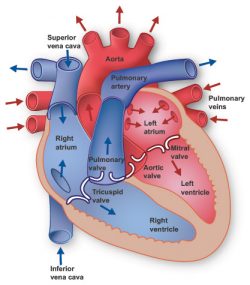Hematologic
Hematologic
Cardio-pulm
Cardiac
Pulmonary
Which pathologies are likely to present with lymph node swelling?
Answer: Hodgkin’s and Non-Hodgkin's lymphoma
Resource: Goodman & Fuller pg 331
Which valves are closed to prevent backflow during ventricular systole?
Answer: AV valves [Tricuspid & Mitral (bicuspid)]
Resource: O’Sullivan pg 419
What condition occurs when a thrombus obstructs a coronary artery?
Answer: Myocardial infarction
Resource: Goodman & Fuller pg 274

Which lung volume or capacity is represented by the maximum amount of air that the lungs can hold after maximum inhalation?
Answer: Total lung capacity
Resource: Goodman & Fuller pg 7.68E307
A 16-year-old patient presents with a chronic productive cough, frequent lung infections, and difficulty gaining weight despite a good appetite. The patient's medical history notes thick mucus secretions and a family history of genetic disorders. Pulmonary function tests show reduced expiratory flow rates. Question: What pathology is most likely present in this case?
Answer: Cystic fibrosis
Resource: Goodman & Fuller pg 393
You are scheduled to treat a patient with a history of Hodgkin’s lymphoma. What "red flag" sign or symptom should you monitor for during your session that would warrant immediate referral to the physician?
Changes in lymph node size, shape, tenderness, and consistency
Goodman & Fuller pg 339
DAILY DOUBLE
1) How would pulmonary valve stenosis directly affect the cardiac output equation?
2) What heart failure would most likely develop as a result?
1) Pulmonary artery stenosis would increase the afterload.
CO = HR x SV
2) Right sided heart failure (hypertrophy of the right ventricle)
O'Sullivan pg 418

How is nitroglycerin administered?
Answer: Sublingually
Resource: Goodman & Fuller pg 270
Name 3 lung volumes or capacities that decrease with restrictive lung disease.
Answer: VC, FRC, RV, ERV, and TLC
Resource: Goodman & Fuller pg 389, O’Sullivan pg 391
A 72-year-old male with a history of hypertension presents with shortness of breath when lying flat, and fatigue. Lung auscultation reveals crackles at the bases. He also reports waking at night gasping for air. Question: What type of heart failure is most likely affecting this patient?
Answer: Left sided heart failure
Resource: Goodman & Fuller pg 279
Name 3 causes of hypovolemic shock
Answer: Hemorrhage, vomiting, diarrhea, dehydration, burns, Addison’s disease
Resource: Goodman & Fuller Table 10.1
Name the heart rhythm seen in the picture
Answer: Atrial fibrillation
Resource: Goodman & Fuller pg 288, O’Sullivan pg 444
What precautions will be in place after a patient undergoes a triple coronary artery bypass graft?
Answer: Sternal precautions
Resource: Goodman & Fuller pg 266 box 9.1
What type of breathing pattern will cause a decrease in blood pH?
Answer: Hypoventilation
Resource: Goodman & Fuller pg 39
A 67-year-old female with a history of COPD presents with swelling in her ankles and abdominal bloating. She reports feeling full quickly and has gained weight recently without dietary changes. Question: What cardiac condition is most likely responsible for these symptoms?
Answer: R sided heart failure
Resource: Goodman & Fuller pg 279
What is the most life-threatening complication associated with sickle cell disease that requires emergency medical attention?
Acute chest syndrome or stroke
Goodman & Fuller pg 352
Name the heart rhythm seen in the picture

Answer: Sinus Tachycardia (300/2.5 = 120 bpm)
Resource: Goodman & Fuller pg 288, O’Sullivan pg 444
What group of cardiac medications will cause frequent urination and possible resulting dehydration, hypotension, and electrolyte imbalances?
Answer: Diuretics
Resource: Goodman & Fuller pg 264 Table 9.5
What type of breathing patterns is represented by deep respirations at an increased rate?
Answer: Kussmaul’s respirations
Resource: Goodman & Fuller pg 210
A 62-year-old male with a history of smoking and diabetes reports leg pain and cramping during walking that resolves with rest. His lower extremities are cool to the touch with weak pulses. Question: What vascular pathology does this presentation suggest?
Answer: Peripheral vascular disease
Resource: Goodman & Fuller pg 301
Explain why patients with thrombocytopenia must avoid aspirin.
Patients with thrombocytopenia have a low platelet count and therefore already have an increased risk of bleeding. A single dose of aspirin can suppress normal platelet aggregation for 48 hours or longer (up to 1 week) until newly formed platelets have been released.
Goodman & Fuller pg 352
Correctly state the circulation of blood through the heart including chambers, valves, veins, and arteries.
Superior vena cava ➡️ Right atrium ➡️ Tricuspid valve ➡️ Right ventricle ➡️ Pulmonary valve ➡️ Pulmonary artery ➡️ Lungs ➡️ Pulmonary veins ➡️ Left atrium ➡️ Mitral (bicuspid) valve ➡️ Left ventricle ➡️ Aortic valve ➡️ Aorta ➡️ Body
🫀 REMEMBER: NONE OF THIS BLOOD FLOWING THROUGH THE HEART ACTUALLY SUPPLIES THE HEART WITH BLOOD!!
How does Amlodipine treat HTN, angina, and Raynaud's?
Answer: Calcium channel blockers cause vasodilation & ⬇️ contractility of smooth muscles
CO = HR x SV
MAP = CO × TPR
Resource: Goodman & Fuller pg 263 Table 9.5
DAILY DOUBLE
1) Which breathing pattern is represented in the illustration?
2) Explain the pH and CO2 changes within this pattern

1) Cheyne-Stokes Respiration
2) pH and CO2 are opposites
hyperventilation = low CO2 and high pH
hypoventilation (apnea) = high CO2 and low pH
O'Sullivan pg 54
A 68-year-old male with a long history of smoking presents with shortness of breath, especially with exertion. He has a thin build with a barrel-shaped chest and uses accessory muscles to breathe. Auscultation reveals diminished breath sounds and prolonged expiration. Question: What respiratory condition does this patient most likely have?
Answer: Emphysema
Resource: Goodman & Fuller pg 379